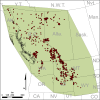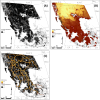Genetic connectivity of wolverines in western North America
- PMID: 39548133
- PMCID: PMC11568290
- DOI: 10.1038/s41598-024-77956-9
Genetic connectivity of wolverines in western North America
Abstract
Wolverine distribution contracted along the southern periphery of its range in North America during the 19th and 20th centuries due primarily to human influences. This history, along with low densities, sensitivity to climate change, and concerns about connectivity among fragmented habitats spurred the recent US federal listing of threatened status and special concern status in Canada. To help inform large scale landscape connectivity, we collected 882 genetic samples genotyped at 19 microsatellite loci. We employed multiple statistical models to assess the landscape factors (terrain complexity, human disturbance, forest configuration, and climate) associated with wolverine genetic connectivity across 2.2 million km2 of southwestern Canada and the northwestern contiguous United States. Genetic similarity (positive spatial autocorrelation) of wolverines was detected up to 555 km and a high-to-low gradient of genetic diversity occurred from north-to-south. Landscape genetics analyses confirmed that wolverine genetic connectivity has been negatively influenced by human disturbance at broad scales and positively influenced by forest cover and snow persistence at fine- and broad-scales, respectively. This information applied across large landscapes can be used to guide management actions with the goal of maintaining or restoring population connectivity.
© 2024. This is a U.S. Government work and not under copyright protection in the US; foreign copyright protection may apply.
Conflict of interest statement
Figures


References
-
- Pasitschniak-Arts, M. & Larivière, S. Gulo gulo. 1995. Mammalian species. 499:1 – 0.
-
- Aubry, K. B., McKelvey, K. S. & Copeland, J. P. <ArticleTitle Language=“En”>Distribution and broadscale habitat relations of the wolverine in the contiguous United States. J. Wildl. Manag.71, 2147–2158 (2007).
-
- Newby, F. E. & McDougal, J. J. Range extension of the wolverine in Montana. J. Mammal.45, 485–488 (1964).
-
- Aubry, K. B., Raley, C. M., Shirk, A. J., McKelvey, K. S. & Copeland, J. P. Climatic conditions limit wolverine distribution in the Cascade Range of southwestern North America. Can. J. Zool.101, 95–113 (2023).
-
- Lukacs, P. M. et al. Wolverine occupancy, spatial distribution, and monitoring design. J. Wildl. Manage.84, 841–851 (2020).
MeSH terms
LinkOut - more resources
Full Text Sources

